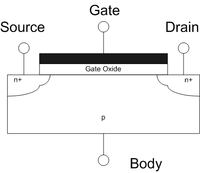
Photo from wikipedia
Molybdenum disulfide (MoS2) has been regarded as one of the most important n-type two-dimensional (2D) transition metal dichalcogenide semiconductors for nanoscale electron devices. Relatively high contact resistance (RC) remains as… Click to show full abstract
Molybdenum disulfide (MoS2) has been regarded as one of the most important n-type two-dimensional (2D) transition metal dichalcogenide semiconductors for nanoscale electron devices. Relatively high contact resistance (RC) remains as an issue in the 2D-devices yet to be resolved. Reliable technique is very compelling to practically produce low RC values in device electronics, although scientific approaches have been made to obtain a record-low RC. To resolve this practical issue, we here use thermal-evaporated ultrathin LiF between channel and source/drain metal to fabricate 2D-like MoS2 field effect transistors (FETs) with minimum RC. Under 4-bar FET method, RC less than ∼600 Ω·μm is achieved from the LiF/Au contact MoS2 FET. Our normal 2-bar FET with LiF thus shows the same mobility as that of 4-bar FET that should have no RC in principle. On the basis of these results, ultrathin LiF is also applied for transparent conducting oxide contact, successfully enabling transparent MoS2 FETs.
Journal Title: Nano letters
Year Published: 2021
Link to full text (if available)
Share on Social Media: Sign Up to like & get
recommendations!